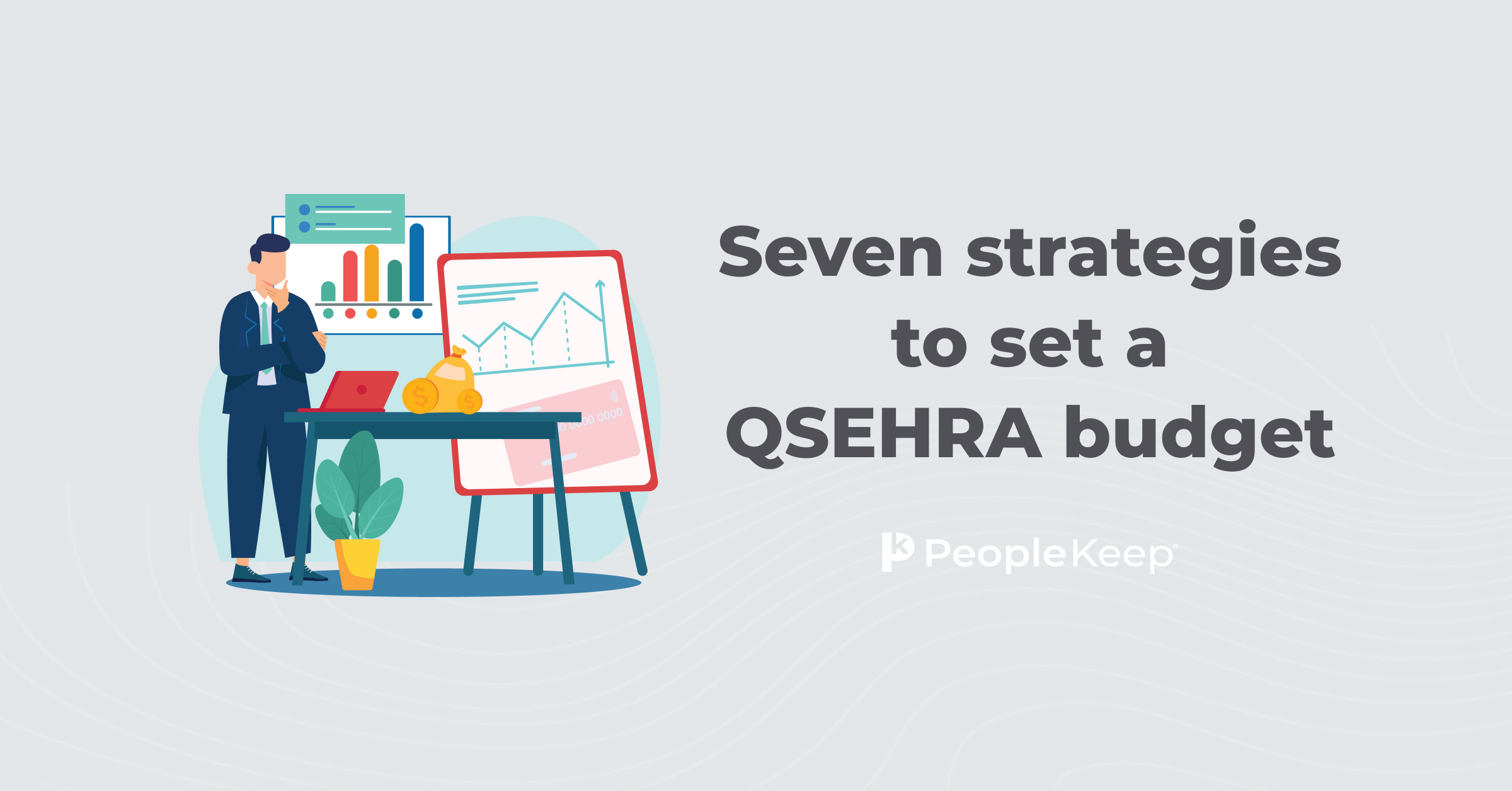QSEHRA self-administration for first-timers
By Elizabeth Walker on May 5, 2023 at 9:03 AM
If you’re a small business owner offering health benefits to your employees for the first time, the qualified small employer health reimbursement arrangement (QSEHRA) is a great first step.
A QSEHRA is an IRS-approved health benefit for small businesses with fewer than 50 full-time equivalent employees (FTEs). With it, they can offer their employees tax-free reimbursements for their individual health insurance premiums and other qualifying health expenses.
However, administering it on your own can be challenging, especially if you’re new to HRAs and IRS requirements. This article covers the steps you need to take to set up your QSEHRA, administer it compliantly, and how PeopleKeep can help you offer one without the hassle.
Want the complete, how-to guide on administering your first QSEHRA? Click to get started
Create a legal plan document
Before eligible employers can begin administering their QSEHRA, they need to draft a legal plan document outlining the details of their plan per Employee Retirement Income Security Act (ERISA) requirements.
Your legal document must include these items to be compliant with ERISA standards:
- A list of named fiduciaries and plan administrators and their responsibilities
- A description of how your QSEHRA is funded and how eligible reimbursements are made
- Information on federal mandates
- The procedure for amending the plan
ERISA doesn’t require these items, but we recommend them to make an even more useful document:
- Eligibility requirements for your QSEHRA
- Effective dates of participation
- A description of benefits provided and excluded, including allowance limits, reimbursement rules, etc.
- Claims procedures
- HIPAA privacy officers and rules relating to the use of protected health information (PHI)
- The procedure for plan termination
No specific penalties apply for failing to prepare and adopt a plan document, but you’ll be fined if plan participants request to see your document and you don’t produce it. If your organization doesn’t share the plan document within 30 days after a participant makes such a request, your organization could be required to pay the participant up to $110 per day.
Create a summary plan description
In addition to the legal plan document, ERISA requires a summary plan description (SPD). As the name suggests, the SPD is a summary of your plan document for your employees to easily read and learn more about their new health benefit—meaning no legal language is necessary.
It should generally inform participants of their benefits, rights, and obligations under the plan. Once it’s all drafted, you should distribute it to your employees at least 120 days before your plan starts or 90 days before a newly eligible employee gets coverage.
Notify your employees about your QSEHRA
This next one’s easy—tell your employees about their new health benefit. The Internal Revenue Code (IRC) requires your organization to send employees a notice regarding your QSEHRA every year, informing them of certain details and rules applicable to the benefit.
Notice requirements include:
- Informing the employee of their benefit amount for the year
- Instructing the employee to share that amount with any health exchange if they apply for a premium tax credit or other subsidies for health insurance
- Explaining to the employee that they may be subject to a tax penalty under IRC Section 5000A if they fail to maintain minimum essential coverage (MEC) during the year
While it’s not a strict rule, it’s recommended that you send your employees the notice at least 90 days before the start of each calendar year in which you’ll offer your QSEHRA.
For example, if you plan to offer a QSEHRA at the beginning of 2025, you must notify your employees by October 3, 2024. You must do the same in 2025 if you’re going to continue the benefit into 2026.
For employees who become eligible for the QSEHRA midyear, including new employees, you must supply the notice on or before the day the employee becomes eligible.
Help employees buy individual health insurance policies
Once your employees know about the benefit, they can start shopping for an individual health insurance plan that will be reimbursable through their QSEHRA allowance. And depending on what you choose to reimburse, they can also begin shopping for out-of-pocket medical items.
This may be a new process for some of your employees. After all, almost 159 million Americans1 have a traditional group health plan, so many of your current employees may not have had individual health insurance coverage before.
Your organization should invest in your employees’ success with your QSEHRA by providing them with resources to understand and shop for an individual plan. This should include providing information about shopping for plans on the individual market, like the health insurance marketplace, or purchasing one directly from an insurance company or broker.
This doesn’t involve advising your employees on which policies to buy. Instead, your organization should make it as easy as possible for employees to purchase policies. You can do this by coordinating with a benefits specialist to help your employees choose and buy a health policy or by directing them to an online service that can assist them.
Establish compliant administration procedures
By this point, you’re done with the prep work and officially ready to administer your QSEHRA! Unlike a group health insurance plan, you don’t have an insurance carrier to take on the responsibilities of administering your QSEHRA. Self-administering your plan can be time-consuming and confusing.
To make it easier, we’ve rounded up eight key components of compliant QSEHRA administration procedures you’ll need to keep in mind to avoid penalties.
1. Updating your plan with staff changes
After an employee leaves or you gain a new one, you must end or extend your QSEHRA benefit appropriately.
When you lose an employee, either through termination or because they leave voluntarily, you must handle any of their outstanding reimbursement requests and end eligibility according to your plan documents.
When you gain a newly eligible employee, you’ll want to give them proper notice of their eligibility for your QSEHRA benefit as soon as you can so they have time to review their coverage options and enroll in a health plan.
When gaining or losing employees, you don’t need to update the plan documents unless the employee is responsible for managing your QSEHRA benefit.
2. Receiving and processing reimbursement requests
Your employees will need to submit proof of payment for any IRS-permitted medical expenses they want reimbursed—your job will be to approve and process them.
Invoices or receipts for reimbursement must include the following:
- The service or product
- The date of the service or sale
- The amount incurred
Some recurring medical expenses, like individual health insurance premiums, only need to be submitted and approved once. This applies as long as the recurring expense matches previously approved costs with the same amount, service provider, and date.
Your organization must review your employees’ submissions and either approve or decline the reimbursement request. Your HIPAA privacy officer or plan administrator should receive these submissions.
You’ll check to see if the charge represents:
- A qualified medical expense under IRS Code Section 213(d)
- The employees’ verifying documents reflect the service or product
- The date of the service or sale and the amount incurred
If everything’s in order, you’ll approve the request. If not, you’ll decline it and follow the process for adverse claims decisions outlined in your plan documents.
3. Handling declined reimbursement requests and appeals
To be ERISA compliant, your organization must have a specified procedure for declining reimbursement requests and appeals.
If you’re declining one of your employee’s reimbursement requests, you must notify them within 30 days of receiving their request. If you declined it because your employee didn’t provide enough information for you to process their request, your employee has 45 days from the day you notified them to get you the missing information.
You can approve the reimbursement request if the new information has everything you need. If not, your employee can appeal the declined request under ERISA. During the appeals process, you must follow regulations issued by ERISA and the Department of Labor and the procedures outlined in your plan documents.
Remember, you must appoint a named fiduciary of the plan to hear the appeal, and the appointed fiduciary can’t be the same person who declined the reimbursement request initially. If the result is in the participant’s favor, you can proceed with the reimbursement request.
4. Paying reimbursements
Once a reimbursement request has been approved, you’re ready to pay it according to the timeline and processes set out in your plan documents.
QSEHRA payments are tax-free to you and your employees, provided they have MEC. While you should ask if they have MEC to receive tax-free reimbursements, if they don’t have MEC, they’ll need to pay taxes on the amount they receive. You’ll also have to add any reimbursement payments you made to your employees’ W-2 as gross income if they say they don’t have MEC.
Generally, it’s best practice to distribute payments alongside your employee’s regular paycheck. However, you can make a payment using any of the following methods:
- Payroll
- Direct deposit
- Check
- Cash
If the reimbursement amount is larger than the employee’s accrued allowance, you should pay them the full amount of their accrued allowance and continue to make monthly payments toward the balance until it’s paid in full or the employee’s annual allowance is exhausted.
5. Record keeping and storing documentation
According to federal government regulations, you must keep an ongoing record of what has been disbursed through your QSEHRA and why. This should include all reimbursement requests, supporting documentation, and whether those requests were approved or declined.
The IRS has a statute of limitations of seven years, so it’s best practice to store this information for at least that long.
Whether you’re operating your QSEHRA up to HIPAA standards or not, the plan sponsor must certify that employees’ health information will be protected and not used for employment-related actions. If you have a HIPAA privacy officer, only this individual should see this information.
You can use spreadsheets or other software to track and store this information, but be mindful of your employees’ privacy as well as standard security procedures.
6. Sending required notices
Other than notifying your eligible employees about the QSEHRA, you’ll need to keep them informed about how you handle their personal health information.
The plan sponsor must certify that employees’ health information will be protected and not used for employment-related actions. If you have a HIPAA privacy officer, only this individual should see this information.
7. Evaluating allowance amounts
As part of your company’s annual budget review, you may want to revisit the monthly allowances you give employees through your QSEHRA. If you’re making any changes, you should let your employees know before the start of the plan year.
With the QSEHRA, you can change monthly allowance amounts in the middle of the plan year. If you do this, you must notify employees as soon as possible. What’s more, if you’re cutting allowance amounts to the point that it would “materially reduce” the plan’s benefits or services, you must notify participants within 60 days.
8. Fulfilling tax reporting requirements
Your organization makes QSEHRA payments on a tax-free basis for both the organization and the employees. During tax time, use box 12, code FF on each employee’s W-2 to report the total permitted benefit available to the employee through the QSEHRA.
Employees are responsible for tracking any reimbursements for incurred health expenses while they don’t have minimum essential coverage. You may need to include these amounts as part of their gross salary, which would make it taxable income.
Consider the costs of self-administering your QSEHRA
It might seem like administering your QSEHRA entirely on your own would be a cost-effective choice. However, it ends up costing a lot more than you’d think.
For example, it’s unlikely that you’ll be able to draft a plan document without the help of an attorney—that cost2 alone can exceed $3,000. Even if you purchase pre-written plan documents, you’re still looking at fees of $200 or more, and the document seller wouldn’t be available to help with any plan amendments.
What’s worse, if your plan documents operate outside the strict QSEHRA definition in Section 9831 of the IRS Code, you could face fines of up to $100 per day per employee.
Penalties aside, the time spent reviewing employees’ reimbursements, submitting payments, record keeping, and sending out annual QSEHRA notices is also a huge drain on productivity from your organization. And between the cost and time needed, you might want to spend the funds and efforts on other parts of your business.
Want help administering your QSEHRA?
If you’re attracted to the benefits of self-administration but wary of the time costs and compliance requirements, PeopleKeep’s cloud-based administration software and award-winning customer support solution is a great choice.
We provide a simple platform for administering personalized employee benefits like a QSEHRA. We help your organization with legal plan documents, verify qualified expenses for you, and automatically send required notices to your employees.
Here’s the best part—unlike working with a third-party QSEHRA administrator, our software simply acts as a support system for self-administrators, so you’re always the one calling the shots.
Conclusion
A QSEHRA can be a powerful health plan alternative for small business owners looking to attract and retain employees. But it needs to be managed responsibly for the benefit to truly deliver value. Self-administering your QSEHRA can seem like a daunting task. Luckily, an HRA administrator can help you if you don’t want to do it yourself.
Whether it’s your first time offering a health benefit or you’d just like to ensure you’re staying compliant, PeopleKeep’s software and support team help thousands of organizations administer HRAs daily—and we’d love to help you, too.
This article was originally published on May 26, 2021. It was last updated on May 5, 2023.
1. https://www.kff.org/report-section/ehbs-2022-summary-of-findings/
2. https://bizcounsel.com/articles/How-Much-Does%20It-Cost-for-a-lawyer-to-review-a-contract
Check out more resources
See these related articles

Should I still offer the QSEHRA when group insurance is cheaper than individual?
If group health insurance seems cheaper for your employees, should you still switch to a QSEHRA? Explore when the QSEHRA is a better choice.

Seven strategies to set a QSEHRA budget
Need help with your QSEHRA budget? Look no further! This resource provides you with seven proven strategies to maximize your benefits.

HRA administration: What features to expect from your provider
Discover the key features of HRA administration. Learn what to expect from your provider to ensure smooth setup, compliance, and employee support.


